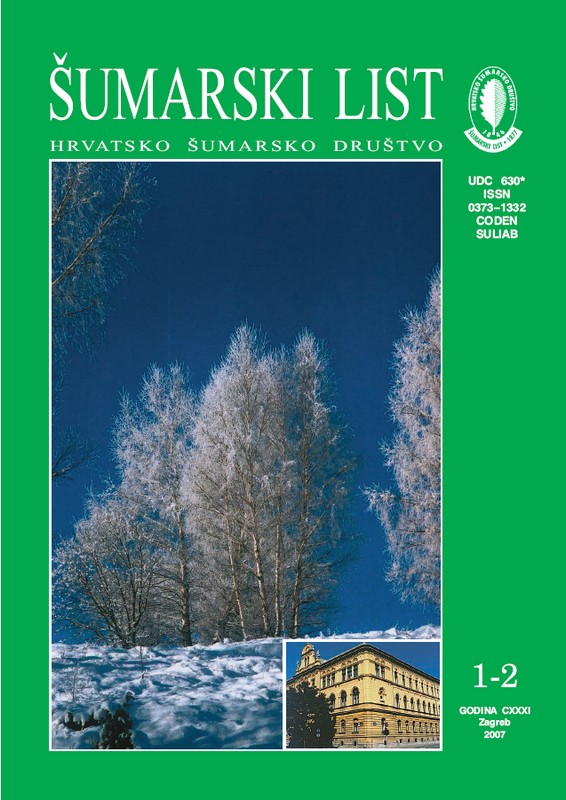
broj: 1-2/2007
pdf (22,2 MB) |
|
||||||||||||||
| IZVORNI ZNANSTVENI ČLANCI | ||
| Božić, M., J. Čavlović, M. Vedriš, M. Jazbec | UDK 630* 523 (001) | |
| Modeling Bark Thickness of Silver Fir Trees (Abies alba Mill.) pdf HR EN | 3 | |
| Ballian, D., F. Bogunić, M. Konnert, H. Kraigher, M. Pučko, G. Božič | UDK 630* 165 (001) | |
| The Analysis of Genetic Variability of Norway Spruce (Picea abies (L.) Karst.) Subpopulation at the Igman Mountain pdf HR EN | 13 | |
| Majnarić. D. | UDK 630* 156 (001) | |
| Harvest and Mortality of the Brown Bear in Gorski Kotar pdf HR EN | 25 | |
| Summary: The analysis of the brown bear bag and mortality was conducted for the period 1997/98 to 2002/03. The brown bear has been managed and harvested in all the hunting grounds of Gorski Kotar since 1997. The amount of 116 animals were harvested in the observed period, 51 animals were affected by mortality, while the total bag included 167 animals. The surface area of the hunting ground, or the management area where harvest is allowed, is 133,569 ha, and the total investigation area is 144,250 ha including Risnjak National Park and non-hunting grounds. The average annual bag for the period 1997/98 to 2002/03 was 27.84 animals; there were 18.17 males and 9.67 females. The average bag/1000 ha was 0.21 animals. Of this number, males accounted for 0.14/1000 ha and females for 0.07/1000 ha. The gender ratio was 63:33 in favour of the males. The average brown bear bag/1000 ha was 0.14 animals. Of this, there were 0.11 males/1000 ha and 0.03 females/1000 ha. Since the gender ratio was 76:24 in favour of the males, it is clear that the male bag was significantly higher than the female bag in the observed period. The average brown bear mortality/1000 ha was 0.07 animals with 0.03 males/1000 ha and 0.04 females /1000 ha. The gender ratio was 59:41 in favour of the females, indicating that the female participation in mortality was significantly higher than the male. A total of 71 % of the planned bag was accomplished. The bag trend from 1997/98 to 2002/23 indicates that the average bag rose by 3 animals per annum. Of this, the average harvest increased by 2.4 animals per year and the average mortality by 0.6 animals per year. The average annual bag from 1997/98 to 2002/23 in Gorski Kotar was 10.3 % of the average annual parent stock, which is significantly less that the average annual population increase, which is 25 % minimally of the average annual parent stock. Since the bag to date has been less than the population increase, the management capacity and the brown bear population growth was achieved. To conclude, hunting management did not endanger the survival of the brown bear in the area of Gorski Kotar. Bear hunt is carried out from high seats exclusively (100 % of the cases) and professional guides are used: therefore, such a hunt has more advantages than disadvantages. Key words: the brown bear | ||
| PRETHODNO PRIOPĆENJE | ||
| Bezak, K., D. Kuric, M. Vrebčević | UDK 630* 612 | |
| The Dissipative Structure of High Forests of Pedunculate Oak (Quercus robur L.) in the Management Unit “Slavir” pdf HR EN | 35 | |
| PREGLEDNI ČLANCI | ||
| Trinajstić, I. | UDK 630* 164 | |
| About the Problem of Differentiation Between the Oaks Quercus pubescens Willd. and Quercus virgiliana. (Ten.) Ten. pdf HR EN | 57 | |
| Sabadi, R. | UDK 630* 721 + 722 | |
| Promotion of Forest and Forest Industry’s Products in Fair Trading pdf HR EN | 61 | |


